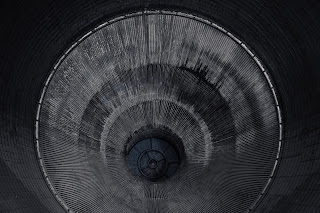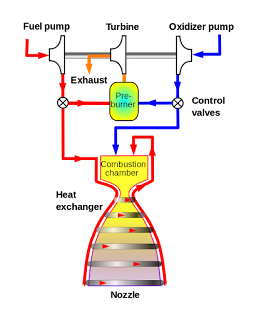Saturn-V for Dummies Part-3: The Engines
 |
| Inside the F-1 engine |
Hey again everybody, in our journey about studying the mighty Saturn-V, till now we saw the history of its development and got a basic overview of the rocket if you haven’t read them yet, I highly recommend going through them now as the previous blogs play a vital role in setting up the context of this blog. But what is this blog really about? As is evident from the topic mentioned above, we’ll be learning about the engines today. A vehicle can only be called a rocket if it has a rocket engine, rocket engines are reaction engines meaning that spew out fluid that propels the rocket as a result of the reaction of that spewing. Now the engines need to spew out fluid with a certain velocity to produce force/thrust. The force shall be able to lift the rocket off the ground. From all that we know about the Saturn-V till now, just try to imagine the enormity of the engines that it would have required. Now let’s dive in without much further ado.
The Engines: Or how the Rocket flew to the Moon ?
There were 2 types of engines used throughout the rocket stages. Let’s see them one by one in detail;
F-1 engine:
 |
| The F-1 engine on display at the INFINITY science center |
The
F-1 engine was developed by Rocketdyne as one of the 2 engines (F-1 and E-1)
to meet a 1955 U.S. Airforce requirement for a large rocket
engine. The E-1 engine however was scrapped as it was seen as a technological
dead end. The development of the F-1 engine continued further as NASA
appreciated its usefulness.
The
engine used RP-1 as the fuel and Liquid Oxygen (Lox) as the oxidizer. Both
oxidizer and fuel were mixed in a 2.27:1 ratio and were burnt in the
combustion chamber.
Many
rocket engines use turbo-pumps to suck the fuel and oxidizer from the
pressurized tanks and inject them into the combustion chamber, to spin the pump,
the F-1 engine followed a gas generator path in which a small amount of
fuel and oxidizer is burnt in a pre-burner chamber which spins the turbine, the
exhaust is usually dumped on board. Then the fuel and oxidizer mixture is burnt
in the combustion chamber and expelled through the bell nozzle. This mechanism
is similar to the one we see in SpaceX’s Merlin Engine but the
difference is, the merlin dumps the exhaust onboard whereas the F-1 uses the
“cooler” pre-burner exhaust as a heat exchanger to stop melting of the nozzle
by over-heating. The “hotter” pre-burner exhaust is then dumped with the main
exhaust! Name a more ingenious cooling technique used in any other rocket
engine, I’ll wait.
 |
| Gas-Generator cycle Engine (F-1 & J-2) |
The
F-1 produced 6770kN of thrust at sea level and 7770kN of thrust in vacuum.
It had a thrust-to-weight ratio of 94:1 (the thrust-to-weight ratio is a
performance measure of a rocket engine obtained by dividing thrust by the
weight of the vehicle), specific impulse (specific impulse is the ability of an
engine to produce an acceleration of 9.81N of force for a certain duration
of time for 1kg of fuel and is usually measured in seconds, it is like the mileage of the rocket
engine) of the engine was 263s at seal level and 304s in vacuum.
This
makes the F-1 engine the most powerful gas-generator cycle engine ever made. In
the Saturn-V vehicle, 5 F-1 were used in the booster (S-IC) stage and operated
for a total of 150s-163s which propelled the vehicle to the first 61km of its ascent.
J-2
engine:
 |
| The J-2 engine on display at London Science Museum |
The
J-2 engine was a vacuum engine meaning that its performance was better at
higher altitudes (outside the earth’s atmosphere) than when operated inside the
atmosphere. As a result of which the primary objective of the engine was upper
atmosphere manoeuvres and Earth Orbit Insertion or Trans Lunar Injection, hence
the engine was designed to be restartable.
The
engine burned liquid hydrogen (LH2) as fuel and liquid oxygen (LO2)
as the oxidizer with a 5.5:1 oxidizer to fuel ratio in the combustion chamber. The
engine’s turbopump cycle is the same as that of the F-1 engine i.e., closed gas
generator cycle where the cooler pre-burner exhaust was used as a heat
exchanger for the nozzle and then was dumped with the main exhaust.
The
engine produced a thrust of 1033.1kN of thrust in vacuum and 486.2kN at sea
level. In a vacuum, the engine had a specific impulse of 421s and at sea level,
it was 200s which makes sense as it was never made to be used as a sea-level
engine. The thrust-to-weight ratio of the engine was 73:18.
In
the Saturn-V, 5 of J-2 engines were used in the S-II second stage and 1 J-2 was
used in the S-IVB 3rd stage. In the 2nd stage, the engine
was burnt for about 360s propelled the vehicle to an altitude of 185km, and
provided a near orbital velocity of about 25000km/h. In the 3rd stage,
the J-2 burnt for about 165s and made the EOI and TLI maneuvers.
 |
| The J-2X engine |
The J-2 engine was one of the most reliable engines NASA ever had. The next-gen J-2 (J-2X) engine was considered for the Earth Departure Stage of the Space Shuttle program.
As
we saw the stats of the engine used in the Saturn-V vehicle are incredible and
straight out insane. Well, then you might be wondering what was the purpose of
the vehicle? Why did we need such incredible power? We already know it’s the
Apollo program, yes, but was the vehicle only used for taking humans to the moon?
Well, no. So, this sets up the context for our next article. In the next
article, we’ll be learning about the missions and accomplishments of this beast
of a launch vehicle. Once it is published, the link will be available here.
If you like our articles then
please follow this blog to get the latest updates
directly to you (buttons are available in the right sidebar or in
the bottom menu bar if you are reading this article on mobile).
To know the basics of the quantum world, astronomy and space exploration you can check out the book "Through the wormhole" on amazon kindle by Ratnadeep Das Choudhury.
Thanks for Reading!!!
-Ayushman Dash












1 Comments
Great!!!
ReplyDelete